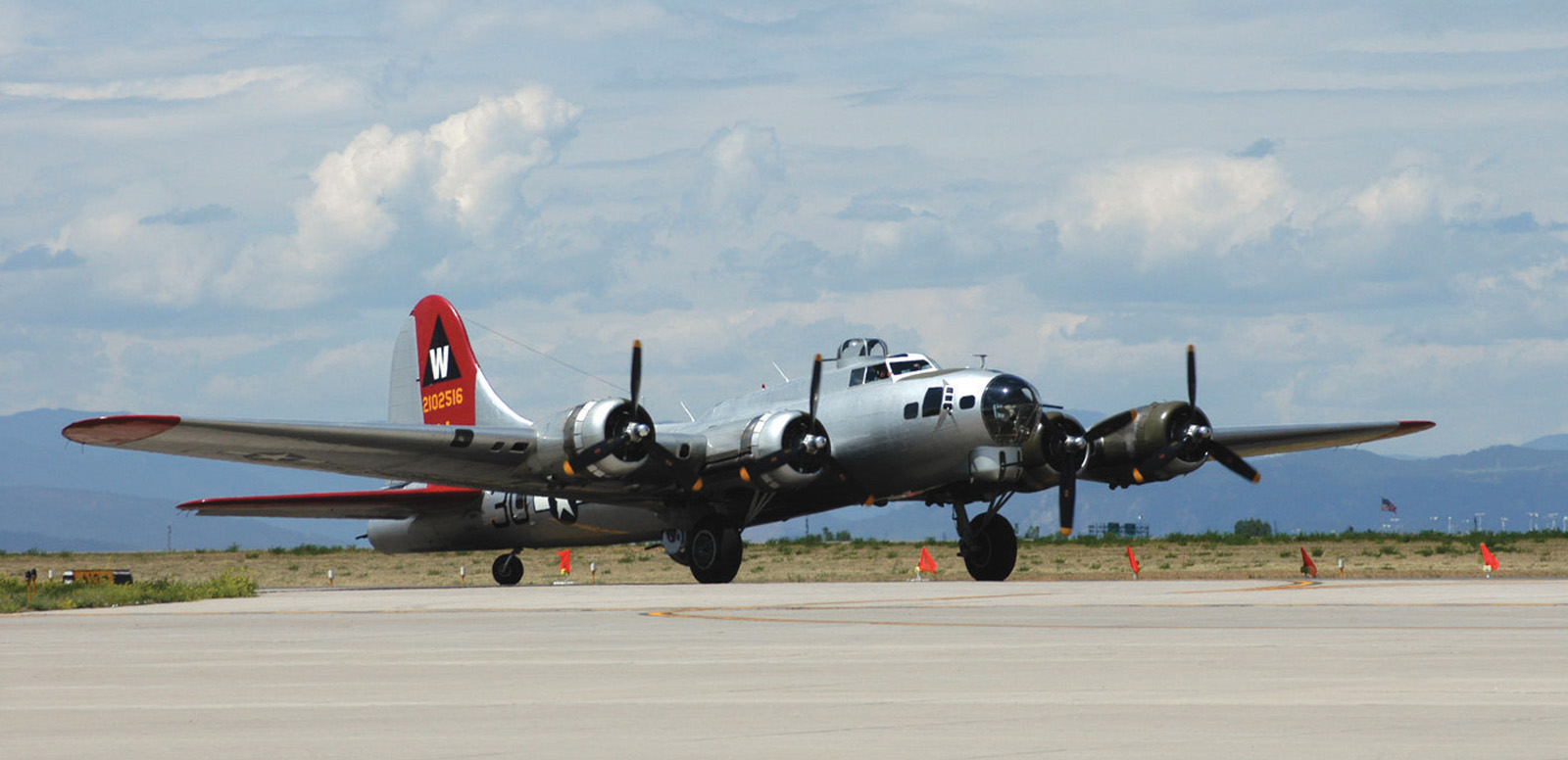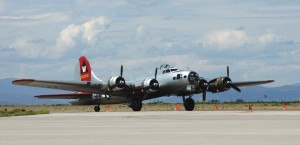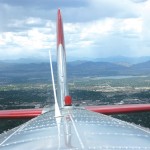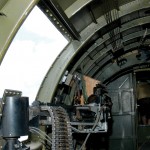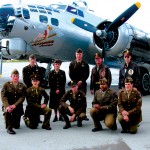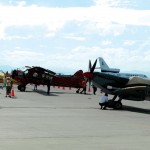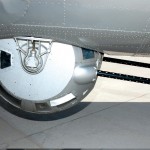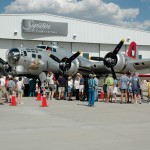By Shari Valenta
Eager passengers aboard the B-17 Aluminum Overcast listen to the four 1,200-horsepower Wright cyclone engines start with anticipation. The vintage machinery screeches and groans as if it’s an old man complaining about leaving the comfort of his easy chair.
This particular plane, built in 1944, had it relatively easy. It was built too late to fly in World War II missions. Today’s crew doesn’t have it so easy; the temperature in the belly of the bird seems well over 80 degrees. In spite of the heat, the17 tons of metal begins its ascent. The combat aircraft vibrates in time with the four noisy propellers. Once the B-17 reaches 30,000 feet, it can cruise at 170 mph. It seems like a miracle when the plane leaves the ground. The passengers smile out the window intrigued to be onboard this “historical tour bus.”
Wings Over the Rockies Air & Space Museum and the Experimental Aircraft Association presented the Flying Fortress’ visit to Centennial Airport, June 9-11. Visitors of the event, held at Signature Flight Service, were able to take a guided tour through the restored B-17 bomber. The experience is unique; 13,000 B-17s were built, but only 10 of them still fly. For an additional cost, individuals could schedule a flight aboard Aluminum Overcast.
That weekend, Signature also hosted several other World War II aircraft, as well as a “Veteran’s Corner” and youth activities. The “Keep it Flying Tour” was intended to commemorate the end of World War II and honor those who sacrificed during that time. To kick off the event, International Jet Aviation Services hosted a hangar dance on Friday, June 9. World War II veterans and civilians alike were able to jitterbug to a 17-piece orchestra playing their big band favorites. The cost was $50 and proceeds went to Wings Over the Rockies.
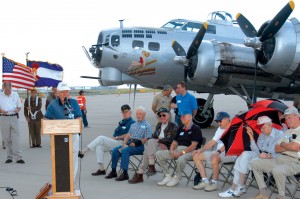
Despite the rain, World War II veterans attended Aluminum Overcast’s arrival on June 8. Speaking at the podium is Robert Doubek from the board of commissioners at Centennial Airport. The Citizen Heroes History Squadron from Gateway High School is holding
Aluminum Overcast is based at the EAA AirVenture Museum in Oshkosh, Wis. After World War II, the plane was sold as war surplus for $750 to a private individual who used it for everything from hauling cargo to pest control. After it was sold, the military equipment was removed.
In 1978, a preservation group, B-17s Around the World, purchased the plane with the intent of restoring it to its original condition. Because of the high cost of maintenance and restoration of the plane, the group donated it to EAA in 1981. After restoration, the aircraft began national tours in 1994. However, the aircraft was temporarily grounded in 2004, after its main gear collapsed upon landing at Van Nuys airport.
Although extensively damaged, the aircraft was repaired to flyable condition and ferried back that fall to EAA headquarters. A major rebuilding project was completed this March.
Aluminum Overcast is painted in the colors of the 398th Bomb Group of World War II. The group flew hundreds of missions over Nazi-held territory during the war. Aluminum Overcast honors one of their B-17s that was shot down in France in 1944. This veterans group helped finance some of the bomber’s restoration.
Most veterans remark that the B-17 was great for being able to withstand a lot of damage during missions. It also had ample firepower. The Flying Fortress received it’s name after a Seattle reporter described it as a fortress because of it’s 13 .50-caliber machine guns—chin, top, ball and tail turrets, waist and cheek guns.
In addition to guns, the B-17 also had a number of crewmembers maneuvering around each other in their bulky bomber jackets. There was a navigator, bombardier, flight engineer, top turret gunner, radio operator, two waist gunners, tail gunner and ball turret gunner, pilot and copilot.
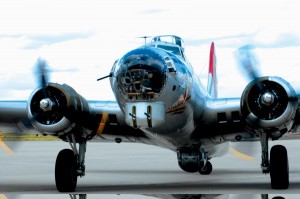
Aluminum Overcast, at Centennial Airport June 9-11, courtesy Wings Over the Rockies Air & Space Museum and the Experimental Aircraft Association, prepares to take passengers for a 20-minute ride.
The ball turret on the plane particularly intrigued visitors of the Aluminum Overcast. In wartime, a man of small stature curled up almost in fetal position to keep a look out for incoming fighter planes from within the clear plastic bubble underneath the B-17’s belly. The highly dangerous job wasn’t an easy one; often, the ball turret gunner was in harshly cold temperatures.
Volunteers from Wings Over the Rockies and the EAA joined former pilots from World War II for Aluminum Overcast’s June 8 arrival. Despite a rainy entrance, veterans were moved to stay and recount their experiences, perhaps for nostalgic reasons. One of them was Mack Connley, a former B-17 pilot.
“I flew 32 missions over occupied Europe,” he said. “The missions I flew were high-altitude, specific targets. We aimed at individual factories during the daytime and the British aimed at killing all the factory workers at night. There was an average loss of 12 percent per mission.”
Gesturing to Aluminum Overcast behind him, he said, “Every time one of these things was shot down that meant ten men died. On some missions, 60 airplanes were lost, so that meant 600 men were killed.”
Women were also there to talk about their experiences in World War II.
“It’s just fun to be here,” said Lucile Wise, a former member of the Women Airforce Service Pilots. “I used to fly a twin-engine airplane. Our mission was to replace men in the Air Force so they could go overseas during World War II. We were restricted to the continental U.S. and we mostly ferried aircraft.”
She said it was a very exciting time.
“We all learned to fly,” she said. “We were able to serve our country by doing something we loved. When the war was over, we were glad it was fought so well. But I remember being disappointed when the men came back. I wanted to stay in the WASP.”
One of the purposes of the B-17 tour is to keep these memories alive and also to educate the public about aviation technology. Wings Over the Rockies plans to continue educating. In addition to their existing Lowry location, the organization is planning to build a 100,000-square-foot aerospace museum at Centennial Airport. The new museum will have a “living hangar” to show the active flight and maintenance operations similar to the Aluminum Overcast exhibit.
“We were young. We had a lot of good memories,” said Connley.
- Pictured is a view out the top turret gunner of the Rocky Mountains.
- Once the vintage aircraft is airborne, passenger Brian Shakley takes a picture out the window.
- The Citizen Heroes History Squadron (JRAFROTC 861) L to R, standing: Drew Oliver, Megan Robbins, Andrew Kurpanek, Clark Hearn (director) and Allen Hiserodt. Robert Gerlitz, Richard Martinez, Matt Burchette, Jean Martinez and Joshua Jefferson are kneeling.
- Visitors got the chance to check out other aircraft, including, from left, a North American T-6 and SNJ-7B, Aviat Husky A1-B, Havilland DHC-2 MK 1 and Supermarine Spitfire.
- The ball turret is underneath the B-17’s belly.
- Friends and former B-17 pilots Mack Connley (left) and Joseph Kenney take a stroll around the restored Flying Fortress. One of the purposes of the B-17 tour is to keep these memories alive as well as to educate the public about aviation technology.
- Aluminum Overcast attracted a steady crowd all weekend.











